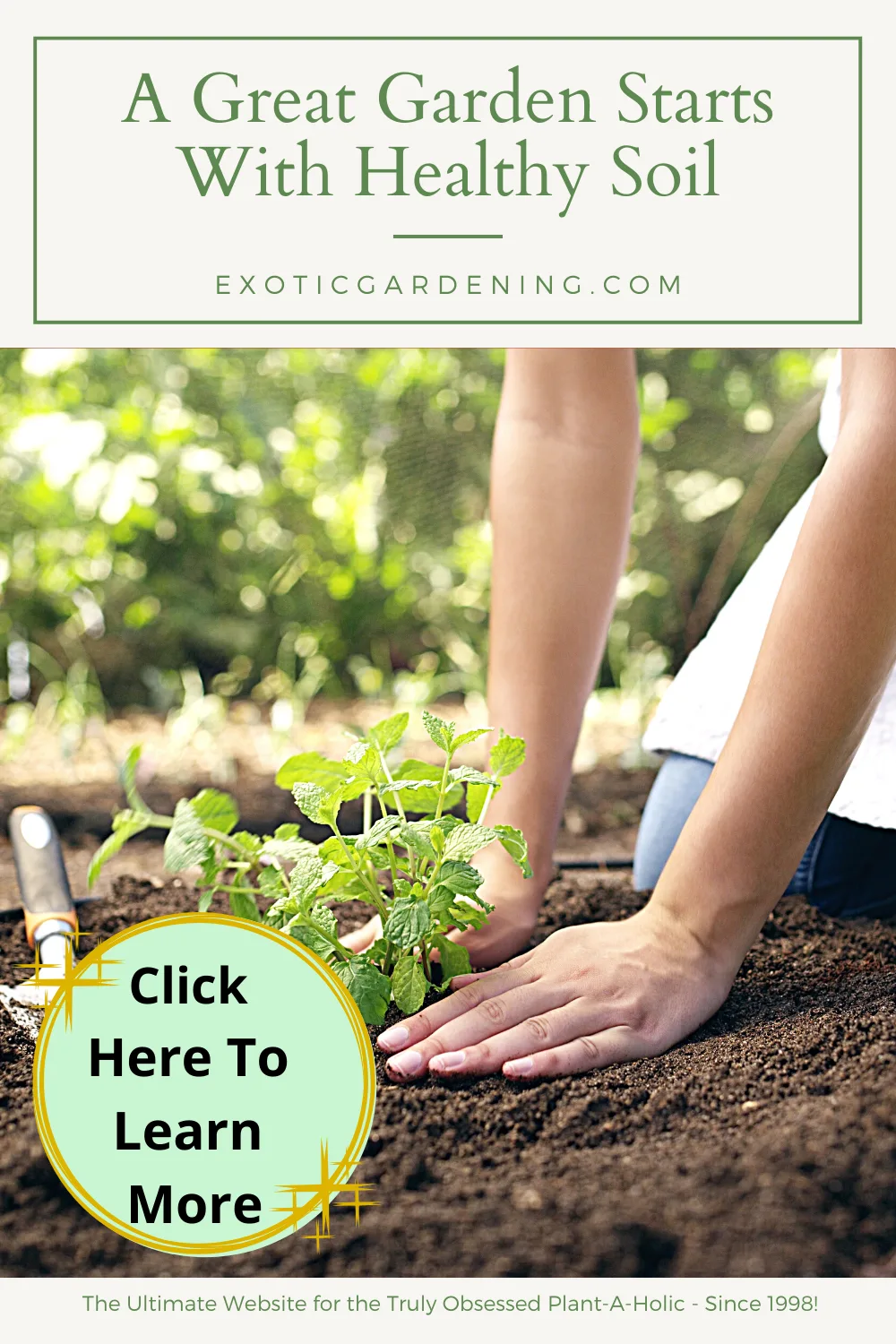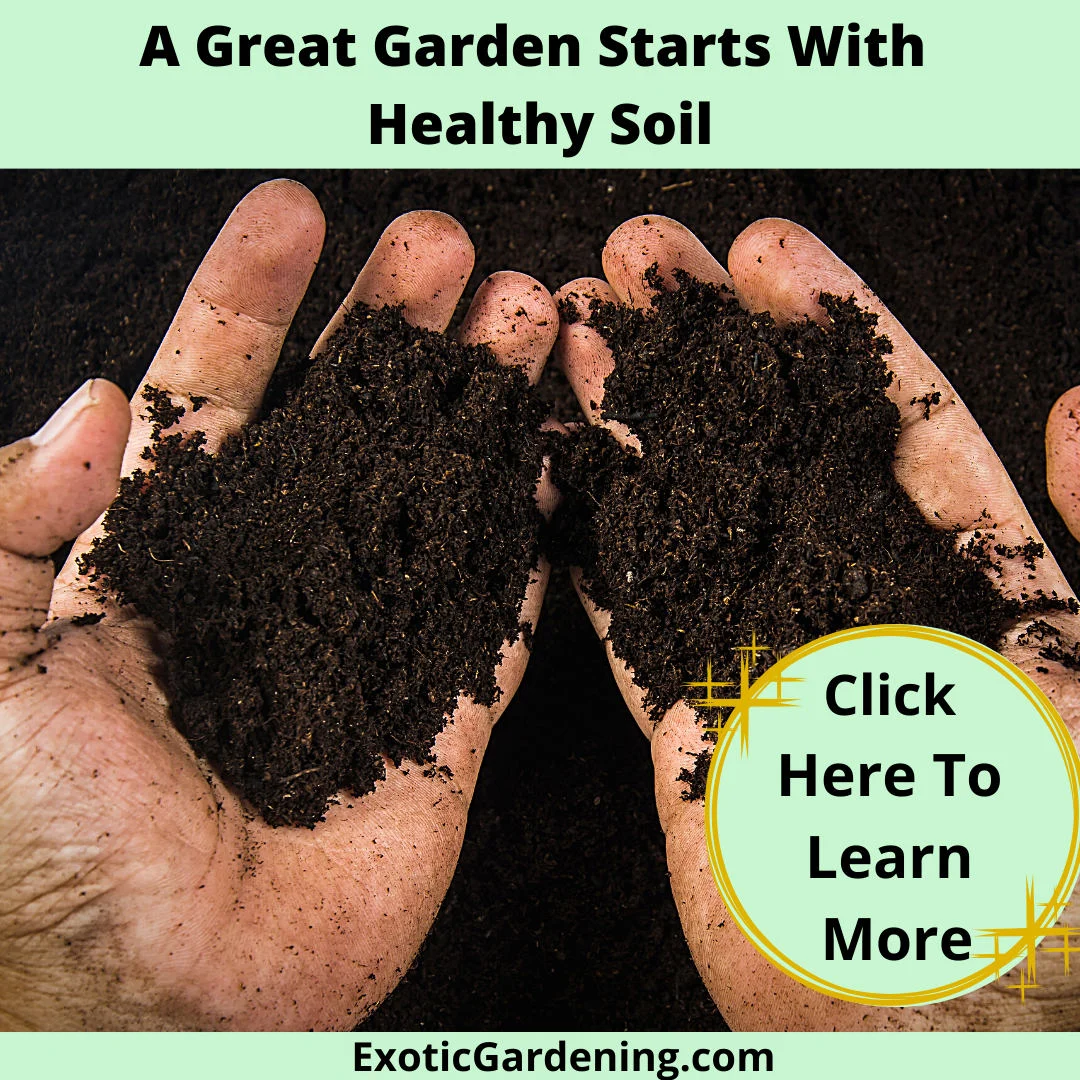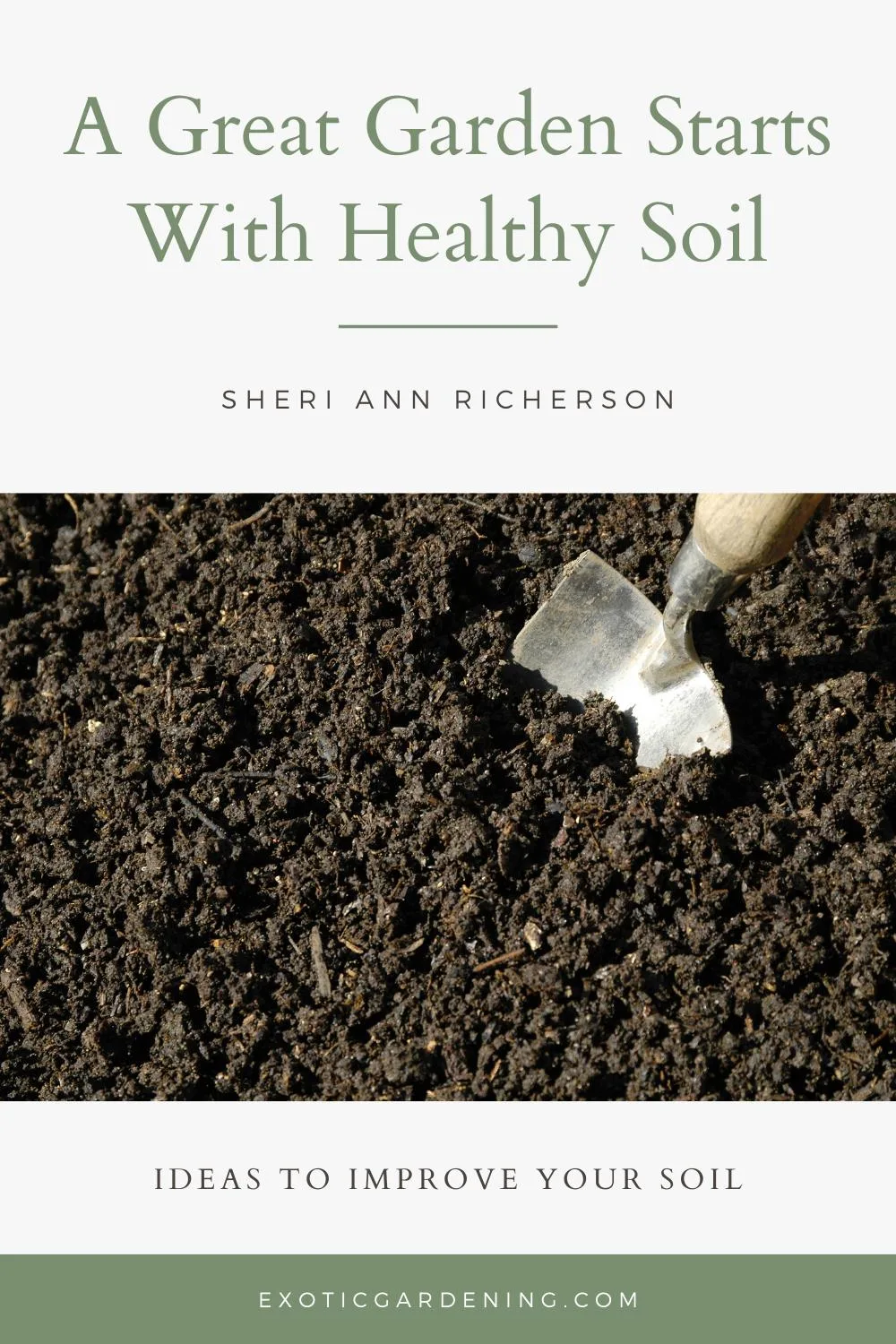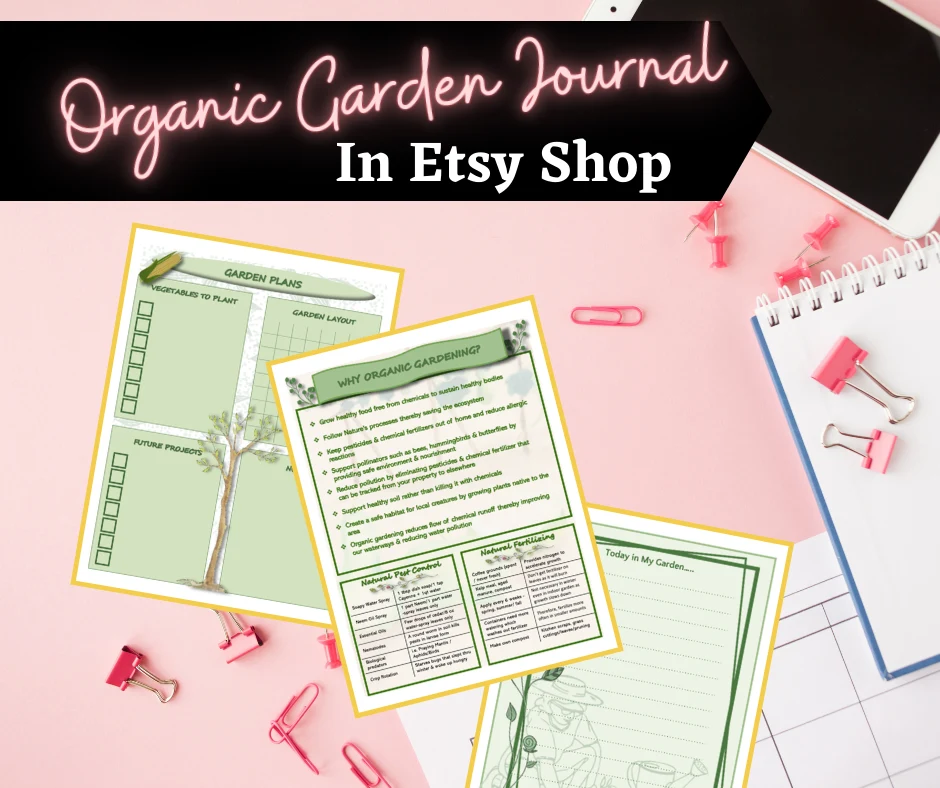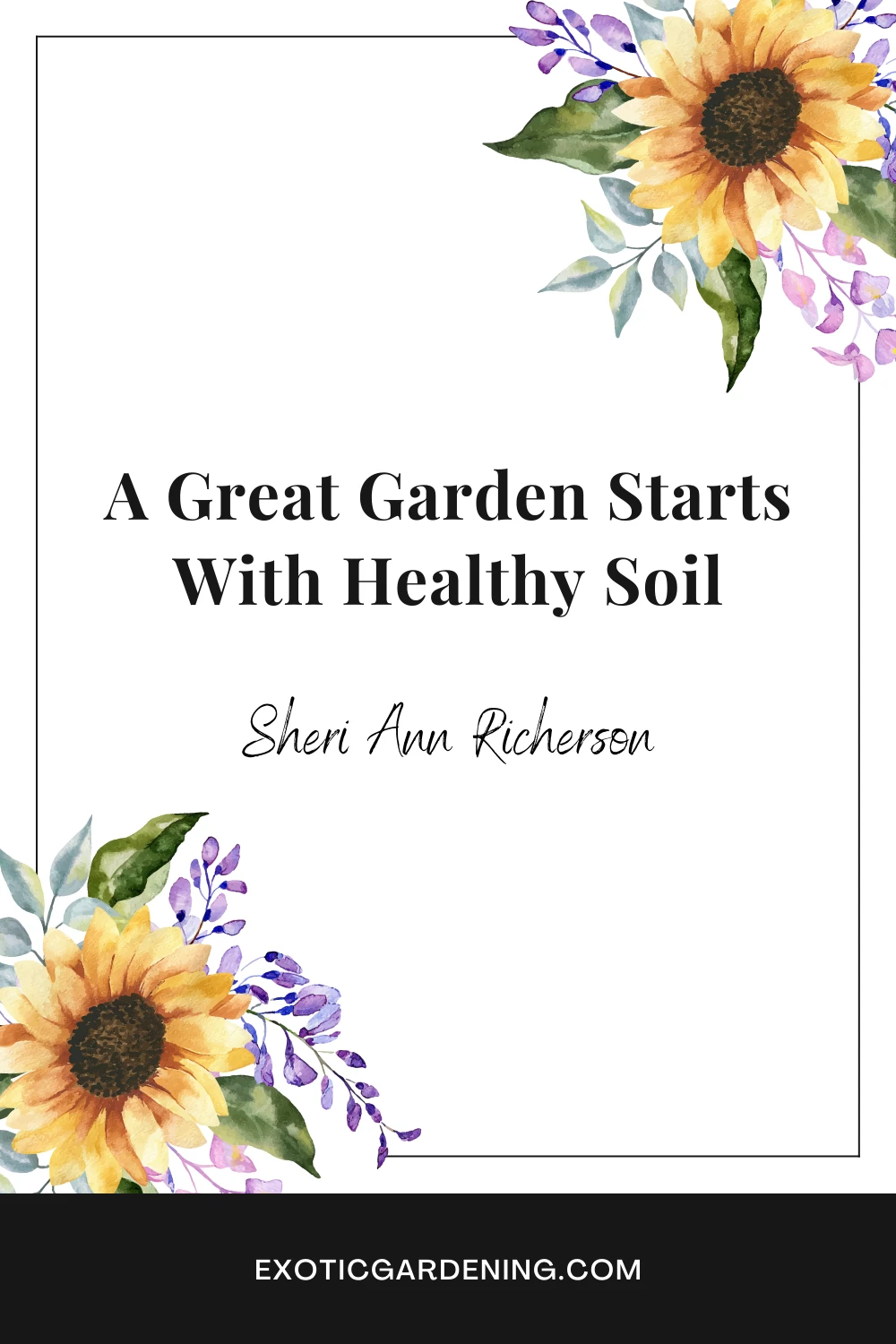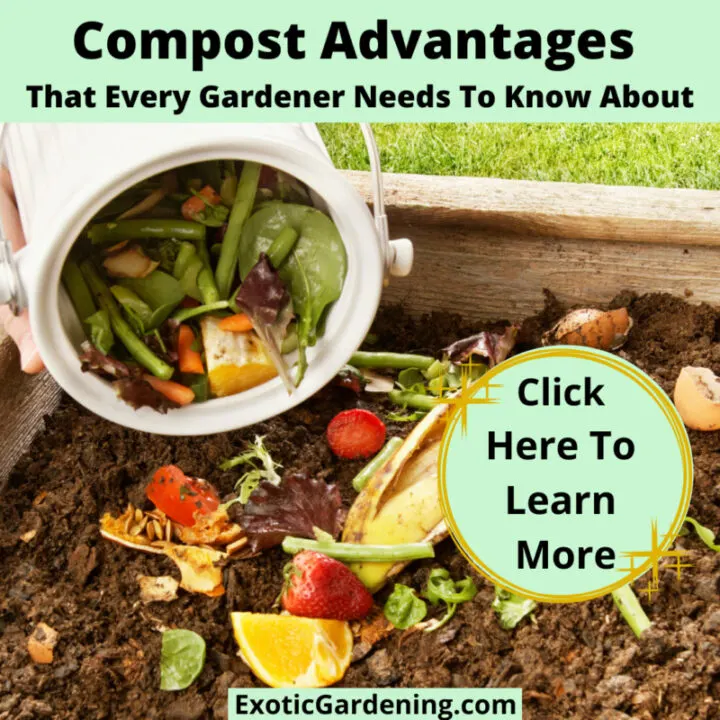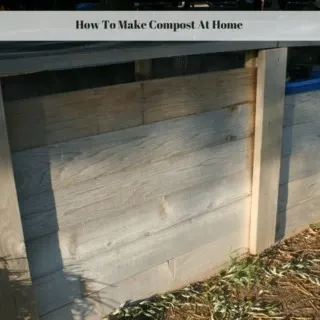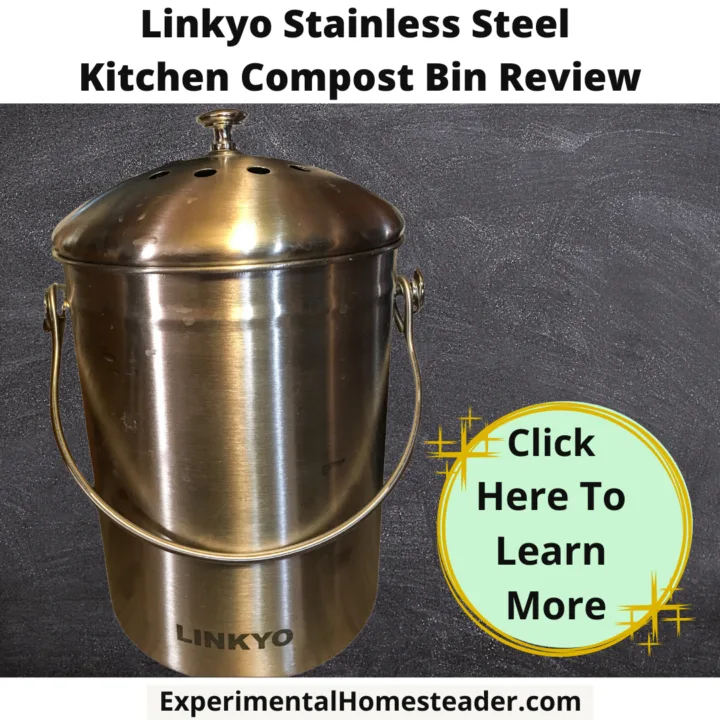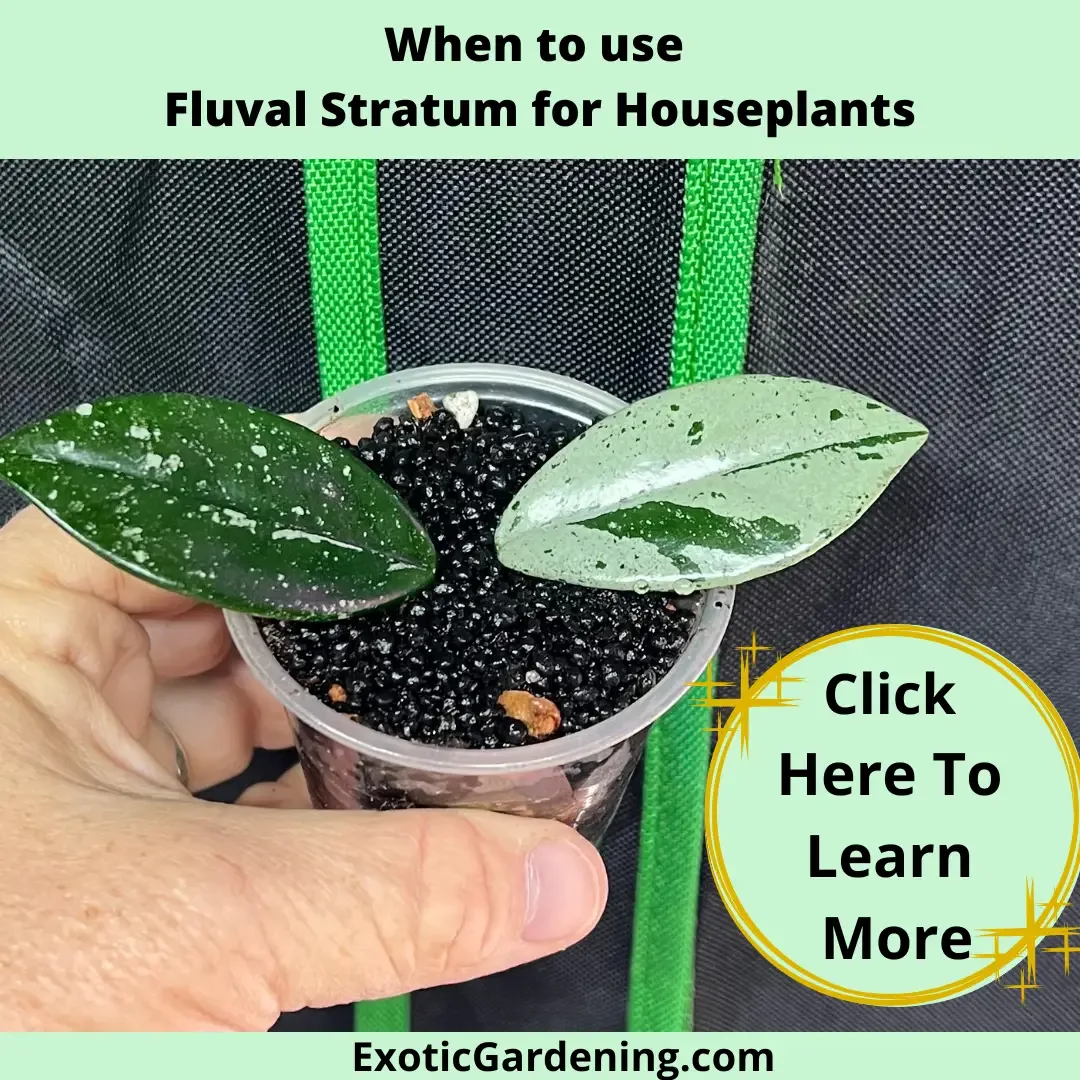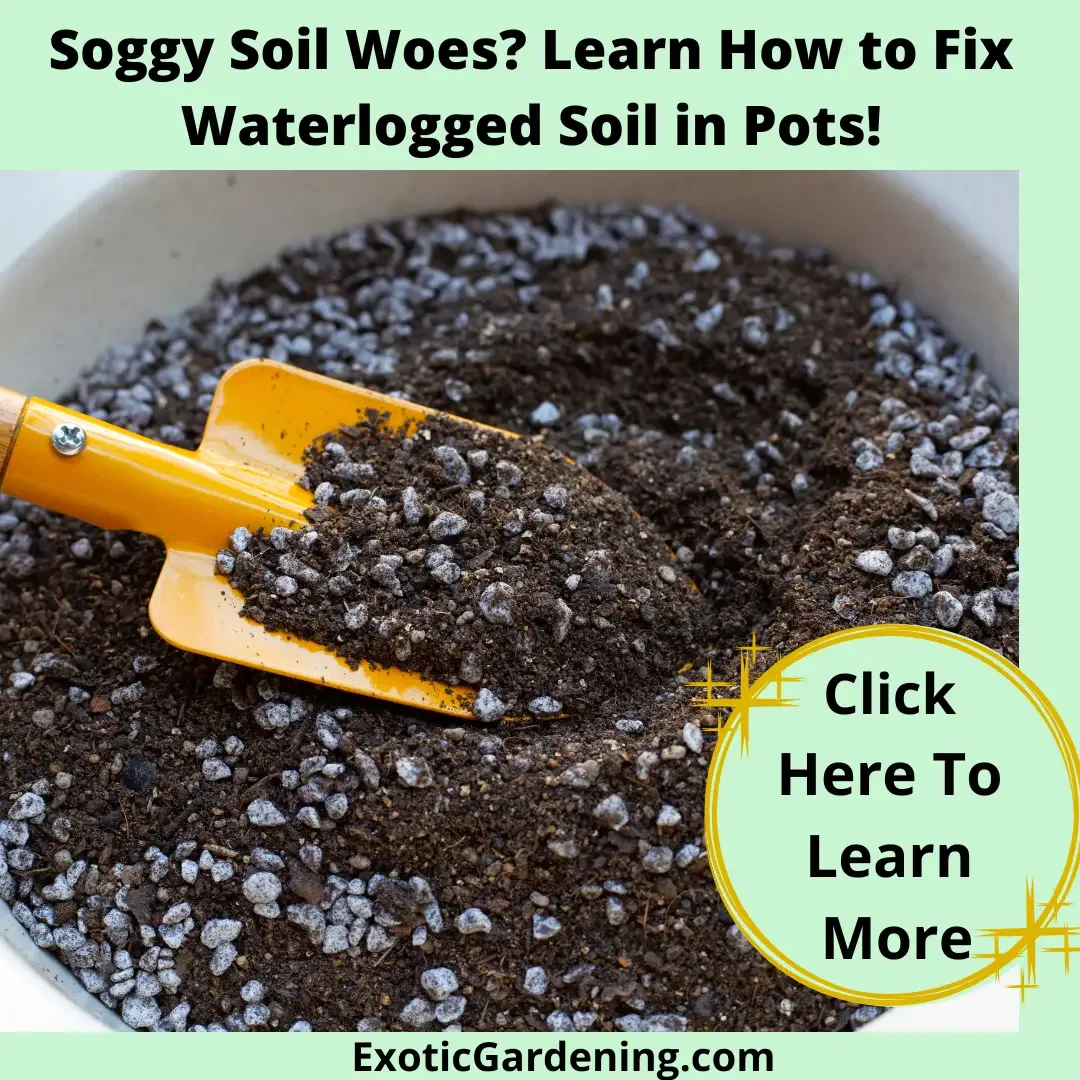Growing a great garden takes more than just popping a few plants into the ground.
It takes healthy soil that is alive and full of nutrients, and it takes proper watering as well
Yes, you can create healthy soil.
By simply adding plenty of organic matter, making sure your ground drains well, and mulching, you will be well on your way to creating the perfect gardening environment.
So, jump right in; learn what it takes for your garden to thrive; and then sit back and reap the rewards.
What Is Healthy Soil And Why Is It Important?
Healthy soil is alive!
Good garden soil is teeming with beneficial micro-organisms and lots of earthworms, too.
Healthy soil is friable, full of oxygen, and well supplies with all 17 of the nutrients necessary for successful plant growth.
The soil in your garden is your basic building material.
Good healthy soil is the foundation upon which all your gardening success depends.
Just as we cannot build a great house on a weak foundation, we cannot have marvelous, abundant, healthy gardens unless we start with first-class soil.
So what if your soil isn't much to start with?
Don't despair; you can do many things to improve your soil.
In this article, we explore different ways to turn ordinary soil into the primo good stuff - the rich, loamy kind of soil every gardener longs for.
Qualities Of Healthy Soil
Healthy soil has five qualities: good drainage, friability, adequate nutrients, correct soil pH, and humus.
For your soil to be top-notch, all five qualities must be present.
Good Drainage Is The First Quality Of Healthy Soil
If soil doesn't drain properly, plant roots become waterlogged, and the plants do not thrive.
When soil doesn't drain properly, tiny channels remain filled with water instead of air, and plants won't thrive no matter what you do.
If soil drainage is poor, plant roots will not go down deep.
As a result, plants will suffer excessively during the slightest dry period because their shallow roots won't have access to water.
How do you know whether your soil has adequate drainage?
Try this test.
Dig a hole one foot deep and fill it with water.
It should drain right away.
If it takes more than 10 minutes for the water to drain, then you don't have adequate drainage.
The Second Quality Of Healthy Soil Is Friability
If you pick up a clamp of soil and squeeze it, does it break up into many little parts?
If so, your soil is friable.
It will allow air and water to pass through.
Soil that lacks friability will either climb up in your hand or simply sift through your fingers.
Nutrients Is The Third Quality
To grow and thrive, plants need water, the right temperature, light, and the right amount of nutrients.
Plants need large amounts of macronutrients, such as nitrogen, phosphorus, and potassium, and smaller amounts of micronutrients - also sometimes called "trace elements" - such as zinc, selenium, iron, and molybdenum.
Different cycles of growth need different nutrients.
For example, a lawn, which is made up mostly of green leaves, needs abundant nitrogen because it is the nutrient mainly responsible for rapid leaf and stem growth and for maintaining the color green.
Few soils have the perfect balance of nutrients each plant needs for optimum growth, but there are many ways we can guarantee that out soil does provide what our plants need to thrive.
The Fourth Quality Of Healthy Soil Is The Correct Soil pH
pH is the measure of a soil's acidity, based on a scale of 0 to 14.
On the pH scale, 0 is extremely acid, and 14 is the top of the chart for alkalinity.
The number 7 is considered neutral.
Some plants, such as blueberries, cranberries, and azaleas grow best in acidic soil with a pH of around 5.
Most garden plants, however, thrive in a pH range between 6 and 7.
If soil is too alkaline, we add soil sulfur or gypsum to it to even it out.
If soil is too acidic, we add limestone to get it into balance.
The Fifth, Final Quality Is The Presence Of Humus, The Organic Matter In Soil
Humus is the result of the decomposition of leaves and other plant material that takes place naturally in the soil.
This is the organic part of the soil.
Humus feeds the earthworms and all the other multitude of beneficial soil organisms.
Soil that is rich in humus will hold water longer, will drain faster and will grow better plants.
It is almost impossible to have too much humus in your soil.
Most soils are lacking in humus and thus they are not really very alive.
Luckily, there are many ways in which we can increase the amount of humus in our soils.
The easiest way is to add organic matter in the form of homemade compost.
How Nutrients Benefit Plants
First, let's get one thing clear: fertilizer is not plant food, no matter what it says on the bag!
Using sunlight, plants make their own food - sugars and starches - through the process called photosynthesis.
The macro- and micronutrients in the soil act like vitamins and minerals for a plant; they are needed in addition to the food the plant makes during photosynthesis.
Macronutrients
Nitrogen (N), phosphorus (P), and potassium (K), are the three macronutrients all plants need and which gardeners are most likely to buy in a bag of fertilizer.
These three are always expressed in the same order - N, P, and K.
On all commercially sold fertilizers, organic or inorganic, the amounts of N, P, and K are expressed as numbers, and these numbers are percentages.
Nitrogen (N)
Nitrogen is abundant in some soils, especially soils right in humus, but is lacking in other soils.
Most soils in the Midwest have abundant nitrogen, whereas soils in the South and in the West tend to be low in nitrogen.
Nitrogen leaches from soil when it is water or when it rains.
If you irrigate your plants often, you many need to add nitrogen.
Because of this leaching action, plants grown in containers always need supplemental nitrogen.
Nitrogen makes plants grow fast; it makes them grow green and tall.
Plants growing in nitrogen-poor soil grow slowly and their older leaves turn yellow.
Too much nitrogen encourages leaf and stem growth at the expense of fruit.
Tomato plants, for example, that gets too much nitrogen will grow very large, but will have very few tomatoes.
Good sources of organic nitrogen are chicken manure, blood meal, and rabbit manure.
Phosphorus (P)
Phosphorus (P) is needed for the growth of roots, flowers, seeds and fruits.
Plants lacking in phosphorus will make few flowers, and their fruits will be small.
Root crops like potatoes, carrots, radish, turnips, beets, and parsnips require abundant phosphorus for optimum production.
Bulb plants, such as daffodils and tulips, also require plenty of phosphorous.
Unlike nitrogen, phosphorous does not move quickly through the soil, and it does not leach out fast as nitrogen.
This means though, that in order to get phosphorous down to the roots of plants, sprinkling phosphorous fertilizer on the top of the soil may not get the job done.
Phosphorous is best applied pre-planting.
Good organic sources of phosphorous are bone meal, compost, and all types of manure.
Potassium (K)
Potassium (K) is sometimes sold as potash.
Potash is a substance that is high in potassium.
Potassium in adequate amounts is necessary for all types of plant growth, but in particular potassium is needed for strong stems.
Adequate or high levels of potassium also tend to impart some extra winter hardiness to plants.
Potassium makes it possible for plants to over-winter when the temperatures drop real low.
Potassium is found in all complete fertilizers as the last number expressed and can be supplied by making good use of wood ashes.
Like phosphorous, potassium doesn’t travel well in the soil, and is useful for pre-planting.
Calcium (Ca)
Calcium (Ca) is another macronutrient, but one that is sometimes called a secondary nutrient.
Calcium is abundant in lime and in gypsum.
If the soil pH of your soil is acidic (6 or lower) then it will pay to add some lime to your soil to add calcium, and to bring your soil pH closer to neutral (7).
If your soil is already neutral, or slightly alkaline, if it has a pH of 7 or above which is more common in the west than in the east, then instead of lime, use gypsum to add calcium to your soil.
Gypsum is also useful for breaking up tight clay soils.
Soils that are lacking in calcium will not grow good crops.
Lemons grown on calcium deficient soils will get a dark soft bad spot on the ends of the fruits.
Much the same thing will be seen with tomatoes grown on calcium deficient soils, the tomatoes will rot on the ends, a condition called blossom end rot.
Magnesium (Mg)
Magnesium (Mg) is another necessary plant nutrient often called a secondary nutrient.
Magnesium is part of the chlorophyll in green plants and is essential for photosynthesis.
Fertilizers with trace elements, manures, compost, and dolomite limestone are good sources of magnesium for plants.
Sulfer (S)
Sulfur (S) is needed for root and flower growth, and adequate sulfur in the soil will also make plants more winter hardy and resistant to cold.
Some fertilizers contain sulfur, and sulfur can be purchased as soil sulfur…usually used to make a soil more acidic.
A good source of inexpensive sulfur is gypsum.
Micronutrients
The micronutrients plants need to grow are boron, copper, chloride, iron, manganese, molybdenum, nickel, and zinc.
Only very small amounts of these nutrients are needed.
Too much of any of them, especially copper, chloride or boron can also cause problems.
Sometimes water from some wells in the west will have too much boron for good plant growth, and tap water in many areas will have too much chloride for optimum plant growth.
If possible, always save and use rainwater for your plants.
For plant growth other nutrients needed are oxygen and carbon dioxide (C02).
By supplying your soil with plenty of organic matter, with humus, you make sure that there is enough carbon dioxide in the soil.
In order to get enough oxygen into your soil, you need to take steps to make sure your soils are friable, that is, that there are enough air spaces in the soil for good root growth.
In tests done on Midwestern cropland, it was shown that pumping extra air into the root zone could double yields of corn.
Air itself is 78% nitrogen and 20% oxygen, so the more air into the root zone, the better.
Besides adding gypsum, compost and organic matter to your soil all of which will help make the soil more friable you should add mulch.
These items will help add more air to the soil.
Mulch is proven to improve the friability of soils.
Mulch encourages the growth of earthworms, and the tunnels the earthworms make through the soil provide space for additional air.
The worm castings from the worms add to the general fertility of the soil.
A good thick mulch holds in water, keeps down weeds, keeps the soil cooler when hot and warmer when cold.
Plants themselves do not require either selenium or iodine, but people do.
We need very tiny amounts of each of these in our diets, but if they are lacking, it can trigger a host of health problems, in particular problems with the thyroid gland, resulting in either hyper thyroid conditions, or low-thyroid conditions.
Areas that get a great deal of rain each year are often lacking in both selenium and iodine, because both of these are water soluble, and are subject to leaching out of the root zone in soils.
In drier areas, typical of the American West, deficiency of selenium and iodine are rarely a problem.
Types Of Soil
In soil science there are hundreds of different kinds of soils, but for our purpose we can pretty much just divide them into three types, then perhaps into variants of those three.
The three main kinds of soil are: sandy, loam, and clay.
Each type of soil has pros and cons, but that said, loamy soil is generally considered the finest soil.
For commercial fruit growing the very finest soils are sandy-loam soils, fertile, friable, and well drained.
Overcoming Soil Problems
What you need to do to improve your soil will depend largely on what type of soil you have in your garden.
Compost will improve any kind of soil, but it will have the most benefit on sandy soils, and the least effect on loamy soils.
Let’s take a look at each of the three soil types, and ways to improve them.
Improving Sandy Soil
These soils usually drain fast and warm up quickly.
Because the individual particles in a sandy soil are so large, there is plenty of air space between the particles, so sandy soils are usually quite friable, loose and easily dug.
The main problem with sandy soils is that they often have little in the way of needed nutrients, and they are prone to drying out too fast.
Sandy soils should always be covered with some kind of mulch to keep them from drying out.
Organic matter added to sandy soils increases the humus, and sandy soils are often lacking in enough humus.
Compost, horse or steer manure, peat moss, and almost any kind of organic matter can be added to sandy soils and it will almost always improve them.
Sandy soils will need more fertilizer than other kinds of soil, and it is wise to use organic fertilizers when possible, to build up the beneficial soil microorganisms.
There will normally be fewer beneficial soil microorganisms in a sandy soil, unless it has been improved by adding extra organic matter.
A thick layer of old hay or straw as mulch best covers sandy soils that are lying fallow, not being used.
If you have sandy soil, try growing green manure crops, such as clover or alfalfa, then turning them under to add organic matter to the existing soil works well with this type of soil.
Sandy soils can be tricky, but generally they are soils that when well managed, can be extremely productive.
Improving Loamy Soil
Loam soils are the ideal soil to have.
They are usually rich, friable, easy to work, quick to warm up, and well drained.
These are those dark, rich, loose soils that grow the best crops.
Few of us are blessed with good loamy soil, but by working with what you have, you can make your own soils more like loamy soil.
Loamy soils require the least fertilizer but the soil pH may need to be monitored.
It might be necessary to add lime to sweeten an acid loam soil, or it might be necessary to add some gypsum or soil sulfur to make a slightly alkaline loam soil more acidic.
Remember, the best pH for most garden plants will be between 6-7.
Improving Clay Soil
Clay soils can be very heavy and hard to work.
Some areas have heavy blue clay that sticks to a shovel so much that it is almost impossible to dig.
People sometimes add sand to clay soils, thinking that this will loosen them up, but don’t do it!
Adding sand to clay soils doesn’t work.
What does work on clay soils is adding large amounts of organic matter and large amounts of gypsum.
Some good farmers will add a ton or more of gypsum, every single year, to their clay soils.
The gypsum adds calcium and it binds to the clay particles and makes the soil looser, easier to work.
Clay soils should never, and I repeat, never be worked when they are wet!
Working a clay soil when it is wet is a sure way to compact it, to make it harder, stiffer, less friable.
Working any soil when it is wet is not a good idea, but with clay soils it is a flat out bad idea.
Let a clay soil dry out before you plow, dig, or cultivate it.
Clay soils may not always drain well.
Dig a hole, fill it with water, and see how fast it drains.
If it drains slowly, this isn’t good and you may well need to tile your soil.
Water will always move downhill, so the first thing you will need to do if you decided to tile your soil is to identify the lowest area of your yard or garden.
This should be an area where the excess water can be drained to.
Just digging small ditches through a clay soil will help drain them, as long as the ditch ends up at a low spot where the water can be drained away or pumped away if need be.
On occasion gardeners will dig small ditches to the lowest spot available, and will dig a deep hole in that spot and put a sump pump in it.
The extra water is then pumped through a large hose to a drain.
Another solution is to put in a rain garden where the water collects.
Most of us though, don’t want to have exposed ditches running through our gardens, and so we use different versions of tiling.
At any large hardware store or farm supply you can now buy inexpensive plastic drain tile.
This drainage tile may be flexible black PVC pipe, or it may be rigid PVC pipe.
The drain tiles have a great many holes in them, on one side.
To install the tiles, you will first need to dig a trench toward an outlet where you can drain away the extra water.
Place the drain tile in the bottom of the trench, with the part with the holes on the sides, not on the bottom.
Cover the drain tiles with soil.
Excess soil water will find its way into the holes and will then run downhill to the drain area.
In the old days gardeners used red clay drain tiles.
The water seeped into the tiles at the joints which were not cemented and drained out of the area.
These old clay tiles worked well, but you can do just as well, or better, now with modern, less expensive plastic drain tiles.
Another way to make a drain through a garden of heavy clay soil, is to dig a trench through the garden to a drain area, then fill in the trench with rocks and gravel.
Commonly gardeners will them place old wooden planks or boards, or even pieces of plywood over the rocks and grave, then cover it all over with soil.
Over time the excess water in the soil will find its way into the rock-gravel filled trench, and will flow downhill to the drain spot.
Finally, how close do you place the drain trenches?
This is a matter of individual choice and may need some experimenting.
It is almost impossible to over-drain a heavy clay soil, however, too many drains placed too close to each other, may eventually make it next to impossible to deep soak plants.
The water will get into the drain and flow away.
If you have heavy clay soils and live in an area with abundant rainfall, then you will almost certainly need to tile your soil unless your property lies on the slope of a hill, and naturally has good, fast drainage.
The Perfect Garden Soil
The perfect garden soil is attainable, no matter where you live.
Remember the key is to create friable soil full of organic matter.
Creating the perfect garden soil is not going to happen overnight, it will take several years to achieve.
Every year you will notice small improvements in your soil.
If you are gardening in raised beds that are filled with good friable soil, you will not need to wait as long as if you are improving the ground itself.
This is just one advantage of raised beds.
However if you have a large area of ground, this may not be practical.
So, to turn your plain soil into good friable soil, simply add lots of organic matter in the form of compost, use some type of mulch and water correctly.
Before you know it, you will be growing happy healthy plants in soil that is truly alive!
Soil Amendments
Linkyo Stainless Steel Kitchen Compost Bin Review
A kitchen compost bin is a must for many people. Find out what features the Linkyo had that I loved and what compost bins I recommend.
When to use Fluval Stratum for Houseplants
Discover the perfect timing to use Fluval Stratum for houseplants and unlock vibrant growth in your indoor oasis. Learn more here.
Soggy Soil Woes? Learn How to Fix Waterlogged Soil in Pots!
Learn expert tips on how to fix waterlogged soil in pots. Revive your plants and create a healthier, thriving garden.

